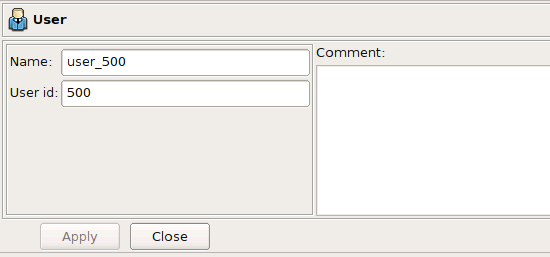Search Users Guide
User service object matches the owner of the process on the firewall that send the packet. It translates to the "owner" match in iptables and "user" parameter for PF.
-
Name:
This is the name of the object
-
User id
The user ID of the user account on the firewall device that the firewall should use to match packets.
-
Comments:
This is a free-style text field used for comments.
The user service object has only one parameter besides the name and comment: it is the user ID that the firewall should use to match packets.
The user service object is only supported for iptables and PF.
Let's look at how the simple rule shown in Figure 5.121 compiles for iptables and PF.
The firewall can associate a packet with a user only if the packet originated on the firewall. Packets that transit the firewall have no information about the user who owned the process that created these packets and sent them out because this process ran on an entirely different computer. For this reason, the object in the Source column must be the firewall.
Figure 5.122. User Service, iptables Compile Output
# Rule 0 (global) # $IPTABLES -A OUTPUT -m owner --uid-owner 500 -j DROP
The user service translated into the owner match for iptables. See the iptables man page for a more detailed explanation of this match.
Figure 5.123. User Service, PF Compile Output
# Tables: (1)
table { en0 , 192.168.1.1 }
# Rule 0 (global)
#
#
block out quick inet from to any user 500
Here the table tbl.r0.s was created to hold IP addresses that belong to the firewall. The rule matches source addresses and also the user ID of the owner using the "user" clause.
The user service object is actually one of the simplest service object types in Firewall Builder, but it provides the facility for a basic per-user control on Linux and BSD machines. This service object can be used in rules with actions that reroute packets ("Route" action) or in the NAT rules; for example, to redirect web access via proxy.
Copyright © 2000-2012 NetCitadel, Inc. All rights reserved.
Using free CSS Templates.


